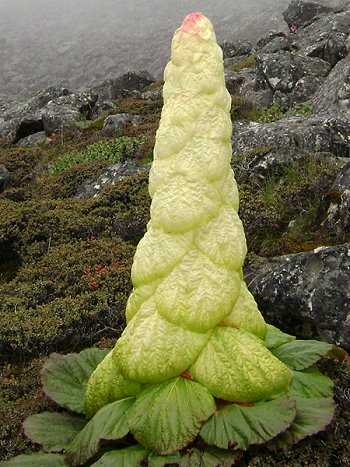
|
|
Sikkim rhubarb - Rheum nobile
|
Sikkim rhubarb - Rheum nobile
Rheum nobile, the Noble rhubarb or Sikkim
rhubarb, is a giant herbaceous plant native to the Himalaya, from northeastern Afghanistan, east through northern Pakistan and India, Nepal, Sikkim (in India), Bhutan, and Tibet to Myanmar, occurring in the alpine zone at 4000-4800 meters altitude.
It is an extraordinary species of rhubarb (genus Rheum). At 1-2 m tall, R. nobile towers above all the shrubs and low herbs in its habitat, and it is visible across valleys a mile away.
The noble rhubarb is a giant
deciduous perennial grown as a vegetable. R. nobile is often called a glasshouse plant because of its
outer curtain of translucent bracts that go over the flowers let visible light through, but not UV radiation. This creates a greenhouse effect that protects the flowers from intense cold! It also prevents UV radiation from hurting the flowers.
An individual R. nobile is a conical tower of delicate, straw-colored, shining, translucent, regularly overlapping bracts; the higher ones have pink edges. Large, glossy, green radicle leaves, with red petioles and nerves, form a broad base to the plant. Turning up the bracts reveals membranous, fragile, pink stipules. Within these are short branched panicles of diminutive green flowers.
The root is often 1-2 m (3-7 feet) long and as thick as an arm, and bright yellow inside. It forms large fleshy rhizomes and large leaves with long, thick (and tasty) petioles (stalks).
The hollow of the stem contains a good deal of limpid water. After flowering, the stem lengthens and the bracts separate one from another, turning a coarse red-brown. As the fruit ripens, the bracts fall away, leaving a ragged-looking stem covered with panicles of deep brown pendulous fruits. As Hooker put their appearance: "In the winter, these naked black stems, projecting from the beetling cliffs, or towering above the snow, are in dismal keeping with the surrounding desolation of that season."
The bracts of R. nobile are 110-170 mm thick and do not differentiate into
palisade and spongy layers. They selectively block ultraviolet radiation while
letting almost all visible light through; thus the developing flowers and the
apical meristem are protected from the intense radiation found in high altitudes.
The major UV blockers found in the bracts are all quercetin flavonoids.
A description of R. nobile was first published by Joseph Dalton Hooker and Thomas Thomson in 1855. Hooker wrote:
"The present is certainly the most striking of the many fine alpine plants of Sikkim; and though in every botanical character, as also in the acid juice of the stem, a genuine Rhubarb, it differs so remarkably in habit and general appearance from any of its congeners, that at first sight it could not be recognized as one of them. I first saw it from a distance of fully a mile, dotting the black cliffs of the Lachen valley at 14,000 feet [4,200 m] elevation, in inaccessible situations, and was quite at a loss to conceive what it could be; not was it till I had turned back the curious bracteal leaves and examined the flowers that I was persuaded of its being a true Rhubarb."
The stems are pleasantly acidic, and they are consumed,
raw or cooked, by the local people, who call the plant Chuka. R. nobile is a commonly used vegetable where it grows wild.
The root is astringent, carminative, depurative, diuretic, purgative and tonic. Small doses act as an astringent tonic to the digestive system, whilst larger doses act as a mild laxative. The flowering stem is used in Tibetan medicine, it is said to have a sour taste and a heating potency. It is antiemetic, diuretic and laxative. It is used in the treatment of swellings and fullness of the abdomen as well as to rid the body of retained fluids.The roots of rheum nobile are known locally in North Sikkim as 'taga' & are traditionally used for dyeing of wool to weave blankets, shawls & carpets.
Source:
http://en.wikipedia.org/wiki/Rheum_nobile
http://davesgarden.com/guides/pf/go/134906/
http://www.pfaf.org/user/Plant.aspx?LatinName=Rheum%20nobile
